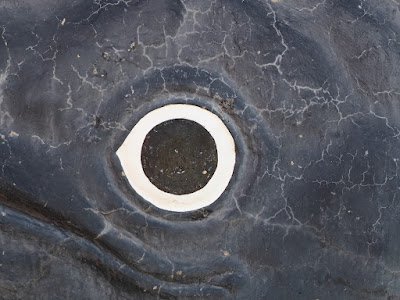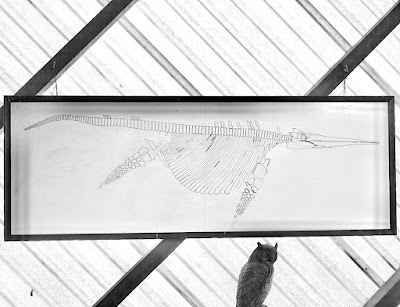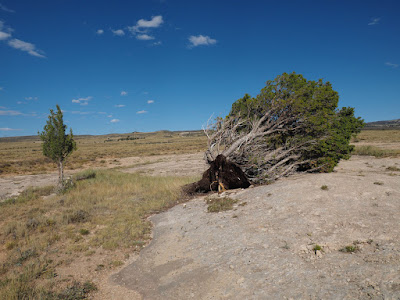 |
| Eye of the Ichthyosaur |
This would be my third attempt. The first was canceled by the covid pandemic. Then the park shut down while pandemic stimulus funds were used for road improvements (still unpaved and washes out occasionally, so check before going). But this year I made it, just in time to set up camp before dark.
 |
| Looking west from Berlin across Ione Valley to the Paradise Range beyond, a fine example of the basin-and-range topography that covers much of Nevada. |
 |
| Berlin Mill in 1910. |
 |
| Two stamp batteries center bottom, for crushing ore plus water and mercury. |
In the early 1950s, amateur fossil collector Margaret Wheat visited Berlin and was astonished by what she saw. She convinced Berkeley paleontologist Charles Camp to take a look, thereby launching the excavation of what would become "the world's largest concentration of exposed fossil ichthyosaurs" (Ornduff et al. 2001).
 |
| Teeth of the Ichthyosaur |
At the Fossil Shelter a small group had gathered in the parking lot, eight in all, a nice size. The Shelter is small and lacks the polish of well-funded visitor centers, as I was happy to discover. I felt far away from the crowds and control that have come to characterize our National Parks. The ranger opened the door, took his position at the front desk, and welcomed us in, providing laminated spiral-bound guides for our tour around a partial excavation of ichthyosaurs. At our own pace, we explored Nevada during Mesozoic time 200+ million years ago. [All quotes below are from the guide or Shelter exhibits.]
Near the front desk, Dr. Camp's reconstruction of Shonisaurus popularis hung overhead, nicely illuminated under the translucent ceiling. However, "There are some notable errors ... [this ichthyosaur] was a much more hydrodynamic predator ... Dr. Camp, however, was only going by the specimens he was excavating and can be forgiven for a few errors when one realizes he had no intact skull, and was working under very primitive and arduous conditions in what was then an extremely remote location."
 |
| Shonisaurus popularis by Charles Camp, with owl. |
Ichthyosaurs are sometimes called sea dragons. One of the earliest collections of a sea dragon fossil was made by a 14-year old nature enthusiast in England—Mary Anning.
I walked slowly around the partially excavated bone bed, which was labeled with letters corresponding to the guide.
 |
| "R" marks ribs. |

 |
| Note the miners' dinner plates (vertebrae). |
Origin of this spectacular collection of bones is still debated (DeCourten & Biggar 2017). The skeletons are nearly complete, with bones roughly in proper position (articulated). Were they suddenly stranded by a very low tide? Or maybe this was a birthing area, with occasional deaths; tiny skeletons have found inside several of the larger ones (or were these ichthyosaurs cannibals?). Perhaps they died in deep water under anoxic conditions. The mystery remains.
Before leaving, I chatted once more with the ranger. He explained that visitation was booming (the new road?), and a reservation system for campsites would be available soon. I felt a little sad; probably there are changes ahead for the Fossil Shelter as well. You may want to visit soon.
Sources
Sources
DeCourten, F, and Biggar, N. 2017. Roadside Geology of Nevada. Mountain Press.
Orndorff, RL, Wieder, RW, and Filkorn, HF. 2001. Geology Underfoot in Central Nevada. Mountain Press.


















